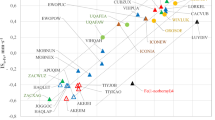Abstract
This paper analyzes the nature of asymmetry of quadrupole doublets in the Mössbauer spectra of the high-spin (HS) and low-spin (LS) forms ofFe x Zn 1−x (ATr) 3(NO 3)2 complexes possessing a polynuclear chain structure. It is assumed that the quantization axis z is directed along the polymer chain. The asymmetric character of bands in the spectra is explained by the anisotropy of iron atom vibrations along the z axis or perpendicular to it, i.e., by Goldanskii-Karyagin's effect. The quadrupole splitting is theoretically analyzed and compared with experiment the electric field gradient on the iron nuclei is negative for the HS form and positive for the LS form. The standard deviations of iron atoms are <x2>=2.78·10−18 cm2, <x2>=0.72·10−18 cm2 for the HS form and <x2>=1.63·10−18 cm2, <x2>=0.72·10−18 cm2 for the LS form at 295 K; <x2>=<z2>=0.26·10−18 cm2 for the LS form at 78 K.
Similar content being viewed by others
References
L. G. Lavrenova, V. N. Ikorskii, V. A. Varnek, et al.,Zh. Strukt. Khim.,34, No. 6, 145–151 (1993).
V. A. Varnek and L. G. Lavrenova,ibid.,,35, No. 6, 103–112 (1994).
M. Sorai, J. Ensling, and P. Gütlich,Chem. Phys.,18, 199–209 (1976).
J. R. Sama and T. B. Tsin,Inorg. Chem.,15, No. 7, 1544–1550 (1976).
E. König, G. Ritter, S. K. Kulshreshtha, et al.,ibid.,,23, No. 13, 1896–1902 (1984).
E. König, G. Ritter, S. K. Kulshreshtha, and N. Csatary,ibid., Inorg. Chem.,23, 1903–1910.
S. Decurtins, P. Gütlich, C. P. Köhler, et al.,Chem. Phys. Lett.,105, No. 1, 1–4 (1984).
P. Gütlich and A. Hauser,Coord. Chem. Rev.,97, 1–22 (1990).
V. I. Goldanskii and R. H. Herber (eds.),Chemical Applications of Mössbauer Spectroscopy, Academic Press New York (1968).
I. P. Suzdalev,Dynamic Effects in Gamma-Resonance Spectroscopy [in Russian], Atomizdat, Moscow (1979).
R. Ingalls,Phys. Rev.,133, No. 3A, 787–795 (1964).
K. Ballhausen,Introduction to Ligand Field Theory, McGraw-Hill, New York (1962).
V. I. Baranovskii,Zh. Strukt. Khim.,7, No. 1, 141–143 (1966).
Additional information
Institute of Inorganic Chemistry, Siberian Branch, Russian Academy of Sciences. Translated fromZhurnal Strukturnoi Khimii, Vol. 36, No. 1, pp. 112–119, January–February, 1995.
Translated by L. Smolina
Rights and permissions
About this article
Cite this article
Varnek, V.A., Lavrenova, L.G. Analysis of asymmetry of the Mössbauer bands of FexZn1−x(4-amino-1,2,4-Triazole)3(NO3)2 complexes with the spin transition1 A 1 ⇄5 T 2 proof of anisotropy of iron atom vibrationsproof of anisotropy of iron atom vibrations. J Struct Chem 36, 97–103 (1995). https://doi.org/10.1007/BF02577755
Received:
Issue Date:
DOI: https://doi.org/10.1007/BF02577755



